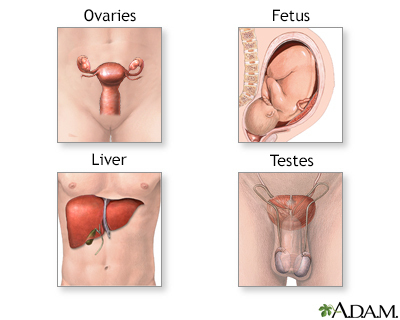Alpha fetoprotein
Definition
Alpha fetoprotein (AFP) is a protein produced by the liver and yolk sac of a developing baby during pregnancy. AFP levels go down soon after birth. It is likely that AFP has no normal function in adults.
A test can be done to measure the amount of AFP in your blood.
Alternative Names
Fetal alpha globulin; AFP
How the Test is Performed
A blood sample is needed. Most of the time, blood is typically drawn from a vein located on the inside of the elbow or the back of the hand.
How to Prepare for the Test
You do not need to take any special steps to prepare.
How the Test will Feel
You may feel slight pain or a sting when the needle is inserted. You may also feel some throbbing at the site after the blood is drawn.
Why the Test is Performed
Your health care provider may order this test to:
- Screen for problems in the baby during pregnancy. (The test is done as part of a larger set of blood tests called quadruple screen.)
- Diagnose certain liver disorders.
- Screen for and monitor some cancers.
Normal Results
The normal values in males or nonpregnant females is generally less than 40 micrograms/liter.
The examples above are common measurements for results of these tests. Normal value ranges may vary slightly among different laboratories. Some labs use different measurements or test different samples. Talk to your provider about the meaning of your specific test results.
What Abnormal Results Mean
Greater than normal levels of AFP may be due to:
- Cancer in testes, ovaries, biliary (liver secretion) tract, stomach, or pancreas
- Cirrhosis of the liver
- Liver cancer
- Malignant teratoma
- Recovery from hepatitis
- Problems during pregnancy
Gallery


References
Driscoll DA, Simpson JL. Genetic screening and diagnosis. In: Landon MB, Galan HL, Jauniaux ERM, et al, eds. Gabbe's Obstetrics: Normal and Problem Pregnancies. 8th ed. Philadelphia, PA: Elsevier; 2021:chap 10.
Carter N, Sharpless Chalk B. Neonatology. In: Kleinman K, Mcdaniel L, Molloy M, eds. The Harriet Lane Handbook. 22nd ed. Philadelphia, PA: Elsevier; 2021:chap 18.
Lee P, Jain S, Pincus MR, et al. Diagnosis and management of cancer using serologic and other body fluid markers. In: McPherson RA, Pincus MR, eds. Henry's Clinical Diagnosis and Management by Laboratory Methods. 24th ed. Philadelphia, PA: Elsevier; 2022:chap 76.
Wapner RJ, Dugoff L. Prenatal diagnosis of congenital disorders. In: Resnik R, Lockwood CJ, Moore TR, Greene MF, Copel JA, Silver RM, eds. Creasy and Resnik's Maternal-Fetal Medicine: Principles and Practice. 8th ed. Philadelphia, PA: Elsevier; 2019:chap 32.